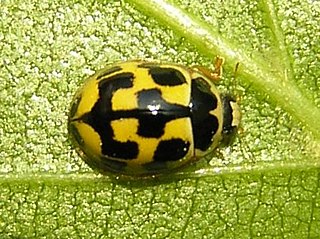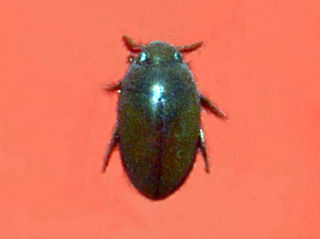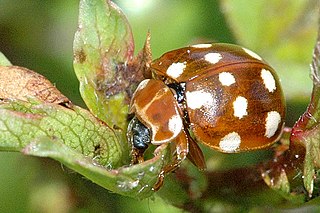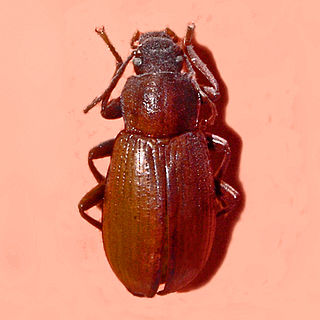
The insects of the beetle family Chrysomelidae are commonly known as leaf beetles, and include over 37,000 species in more than 2,500 genera, making up one of the largest and most commonly encountered of all beetle families. Numerous subfamilies are recognized, but the precise taxonomy and systematics are likely to change with ongoing research.

The rove beetles are a family (Staphylinidae) of beetles, primarily distinguished by their short elytra that typically leave more than half of their abdominal segments exposed. With roughly 63,000 species in thousands of genera, the group is currently recognized as the largest extant family of organisms. It is an ancient group, with fossilized rove beetles known from the Triassic, 200 million years ago, and possibly even earlier if the genus Leehermania proves to be a member of this family. They are an ecologically and morphologically diverse group of beetles, and commonly encountered in terrestrial ecosystems.

Geotrupes stercorarius is a species of earth-boring dung beetle, common name Dor.

Propylea quatuordecimpunctata is a small lady beetle, belonging to the family Coccinellidae. It is sometimes referred to by the common name 14-spotted ladybird beetle, or simply P-14.

Valgus hemipterus is a smallish species of scarab beetle found in the Northern Hemisphere.

Noterus clavicornis is a species of beetle belonging to the family Noteridae.

Calvia quatuordecimguttata, the cream-spot ladybird, is a species of ladybird in the family Coccinellidae. Its distribution is holarctic, it being found in Europe and through the East Palearctic to Japan. It is introduced to North America. This ladybird is generally 4 to 5 millimetres in length and varies in appearance depending on the geographical location. It usually lives in hedgerows and deciduous trees.

Clytra laeviuscula, the ant bag beetle, is a species of short-horned leaf beetles belonging to the family Chrysomelidae, subfamily Cryptocephalinae.

Crioceris duodecimpunctata or the spotted asparagus beetle is a species of shining leaf beetle belonging to the family Chrysomelidae, subfamily Criocerinae.

Lilioceris merdigera is a species of beetle belonging to the family Chrysomelidae, subfamily Criocerinae.

Scaphidium quadrimaculatum, common name orange-spotted scaphidium or shining fungus beetle, is a species of beetles belonging to the family Staphylinidae subfamily Scaphidiinae.

Chrysomela is a genus of leaf beetles found almost throughout the world, but not in Australia. It contains around 40 species, including 7 in eastern and northern Europe. It also includes at least 17 species in North America, including the cottonwood leaf beetle Chrysomela scripta.

Anastrangalia dubia is a species of beetle of family Cerambycidae.

Anotylus tetracarinatus is a small rove beetle with a wide distribution. It is the most common species of the genus, and maybe even of the family, in the whole of Central Europe.

Oenopia conglobata is a species of ladybird (Coccinellidae) native to continental Europe, Asia and Africa. Its colloquial names in Germany are 'poplar ladybird' and Kugelige ladybird.

Cryptocephalus trimaculatus is a species of cylindrical leaf beetle belonging to the family Chrysomelidae, subfamily Cryptocephalinae.

Lilioceris is a genus of beetles in the leaf beetle family, Chrysomelidae. The genus was first scientifically described in 1912 by Edmund Reitter. Lilioceris belongs to the subfamily Criocerinae and tribe Criocerini.

Stenomax aeneus is a species of darkling beetles in the subfamily Tenebrioninae.

Alosterna tabacicolor is a species of beetle in family Cerambycidae.

Coptocephala is a genus of beetles belonging to the family Chrysomelidae. The genus was first described by Louis Alexandre Auguste Chevrolat in 1836.





















